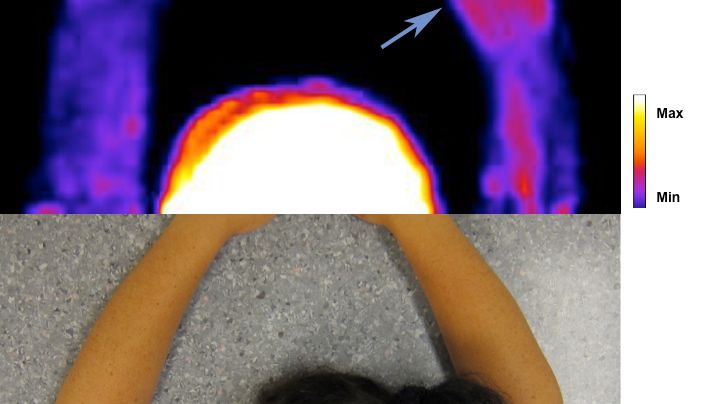Press release -
Pain processes in tennis elbow illuminated by PET scanning
Physiological processes in soft tissue pain such as chronic tennis elbow can be explored using diagnostic imaging methods. This is demonstrated by researchers from Uppsala University and the results are now being published in the prestigious journal PLOS ONE. The pain physician and researcher Magnus Peterson is presenting a new use of positron emission tomography (PET) and a tracer for the signal receptor NK1 for visualising a physiological process associated with pain.
Chronic pain is a major problem, with considerable socioeconomic costs and suffering of the individual. Musculoskeletal pain is the most common type of pain and is one of the most common reasons for consultation in health care. However, pain from soft tissues, (i.e. pain from muscles, tendons and ligaments) is still lacking effective methods for localization and diagnosis of underlying pathophysiological mechanisms.
This means that diagnosis still depends on clinical examination, which provides no guidance regarding what mechanisms might underlie the pain. Consequently, treatment proceeds purely on an empirical basis. An improved diagnostic method that allows not only diagnosis of localisation of the painful tissue processes, but also can provide guidance regarding what pathophysiological mechanisms are involved, would therefore be highly valuable.
Magnus Peterson has worked with positron emission tomography (PET), a tool for diagnostic imaging, in combination with a specific tracer for the signal receptor NK1. The tracer is injected into the blood where it circulates through the body and binds to available NK1 receptors. The signal from the radioactive tracer can then be captured as an image outside the body using PET.
This is the first time an up-regulation of NK1 receptors has been visualized by diagnostic imaging in painful tissue in humans. The study clearly reveals an image of elevated levels of NK1 in the painful area compared with the healthy arm.
Following tissue damage there is an up-regulation of the neuropeptide substance P and its receptor NK1. This occurs not only in the dorsal horn of the spinal cord, but also in the peripheral painful tissue. This up-regulation is part of an interaction between peripheral nerves, immune cells, and the tissue itself that seems to help guide the body’s own repair process. In chronic tennis elbow, this up-regulation of the substance P-NK1 system lingers on. This is what the researchers have managed to visualize with the help of PET and the marker for NK1.
The method is promising, but the costs are still high. PET is a complicated procedure, which requires costly equipment.
- In the future, we hope to be able to develop less expensive markers that enable us to use the method in everyday clinical practice. We also aim to create markers for other physiological processes that we know are active in chronic soft tissue pain, says Magnus Peterson.
The article is published in the October issue of PLOS ONE Peterson M, Svärdsudd K, Appel L, Engler H, Aarnio M, et al. (2013) PET-Scan Shows Peripherally Increased Neurokinin 1 Receptor Availability in Chronic Tennis Elbow: Visualizing Neurogenic Inflammation? PLoS ONE 8(10): e75859. doi:10.1371/journal.pone.0075859
For more information, please contact Magnus Peterson, mobile: +46 (0)70-288 27 68, e-mail: magnus.peterson@pubcare.uu.se
Topics
Uppsala University -- quality, knowledge, and creativity since 1477
World-class research and outstanding education of global benefit to society, business, and culture.
Uppsala University is one of northern Europe's highest ranked academic institutions. www.uu.se

